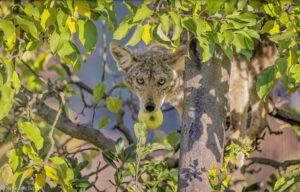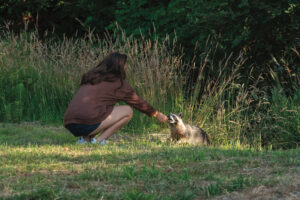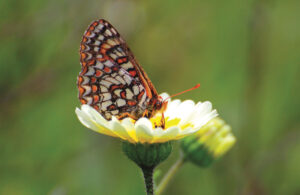
Wildlife fascinated me long before I started photographing it. I am always intrigued by animal behavior: what motivates them, the bonds between them, how they raise their young and how human behavior impacts their survival. The wildlife I gravitate toward photographing — like bobcats, coyotes, foxes, and badgers — are sentient beings, with familial bonds, impulses and instincts. A picture like this one, which I took of a young fox kit, looks like I’ve just showed up in its life and pressed the shutter button. But in fact, I spent many hours observing this gray fox family from a distance, learning their habits to ascertain when a kit would likely be sitting in a spot with good light. A shot like this is made possible because of my interest in and respect for the animal.
Developing empathy for wildlife means understanding that a particular animal isn’t simply there to entertain or perform for us. Capturing the beauty of their natural behavior is the essence of my photography.
For the wildlife we photograph, every moment is about survival. Their waking hours are spent eating, reproducing, and raising young. Human presence is in itself a disruption, which can lead to an apparent tension. Nature photographers — whether professional or amateur — want to get a memorable shot. And it is typically images that evoke emotion that create the most impact. Yet we care about our photo subjects and want to minimize our intrusion on their lives.
In thousands of hours in the field, I have had the opportunity to not only practice my own skills, but observe what works and what doesn’t work for other photographers as well. I have found time and again that taking an ethical approach improves your chances of getting a memorable photo.
How you conduct yourself around wildlife dictates the level of disruption. Slow, quiet movement — avoiding direct eye contact or walking towards the animal directly — while maintaining a good distance away is best to avoid startling an animal. I try to stay low to the ground and still. Watching quietly for a bit without taking a photo also helps, as the sound of the shutter is another disruption. The cumulative impact of multiple disruptions in a short timeframe – car stopping, door opening, person approaching and shutter clicking – will often cause an animal to run.
Approaching a place or animal with curiosity helps to cultivate patience. You truly never know what behavior will unfold (I have been surprised many times). Sitting back quietly and waiting gives a photographer the best opportunity to see something unique. While sitting with an animal I am watching that animal, and simultaneously scanning for other changes in the environment, such as other animals arriving or leaving the area, bird activity including vocalizations, and changes in light or weather that would affect my camera settings.
Learning about a particular species’ behavior allows you to anticipate interesting behavior and also recognize signs of stress in the animal. For example, bobcats about to pounce will often crouch low, flatten their ears and twitch their tail. Coyotes that are hunting will tilt their heads from side to side when listening for a gopher, and just before leaping forward for a kill, they will rock back slightly. Scrub jays sound an alarm when a predator comes near, so listening for a scrub jay is a good indicator of a fox or bobcat arriving.
Carefully watching an animal’s eyes, ears and body posture will provide clues to the degree of distress, in addition to listening for vocalizations. Running away or hiding is an obvious sign of a stressed animal but before an animal does that, it often displays its discomfort in other ways. Badgers try to make themselves appear larger and more intimidating by straightening up and baring their teeth. Initially, bobcats will flatten to ground in an attempt to hide; owls will widen their eyes. A gray fox will bark at a perceived threat to its kits. Wildlife will generally use the minimum energy necessary to avoid a perceived threat. Developing an understanding of a particular animal allows you to recognize subtle cues and then back away or leave altogether.
When an animal is relaxed, it will engage in behavior like hunting, grooming or napping. Parents who feel safe will bring food back to their young – but a parent who perceives a threat may stay away from a nest or den and delay feeding young animals. If you see a parent circling but not coming in, it is best to move away, and let them feel comfortable enough to reunite with their offspring. Seeing babies of any species requires extra patience and a calm demeanor, as offspring are typically more skittish than adults.
Every photographer has to decide what feels comfortable in the field. For me, personally, it is important not to intentionally manipulate animal behavior. Every action taken by an animal burns calories that they have to replace. Research shows that attracting predators or birds with bait (live or dead animals) can cause changes in behavior that are detrimental to the animal and may also expose the animal to diseases.
Remember, they are an exotic species in the Western United States, and are rapidly increasing their geographic range and range of habitats. Are they outcompeting or excluding native species in the process? How would we know? We have done almost nothing to monitor changes in the assemblage of mushroom species in areas before and and after the incursion of death caps.
Further Reading
Pringle et al, “The ectomycorrhizal fungus Amanita phalloides was introduced and is expanding its range on the west coast of North America,” Molecular Biology 2009
Lockhart et al, “Simultaneous emergence of multidrug-resistant Candida auris on 3 continents confirmed by whole-genome sequencing and epidemiological analyses,” Clinical Infectious Diseases 2017
Battalani et al, “Aflatoxin B1 contamination in maize in Europe increases due to climate change,” Scientific Reports 2016
Ethical Photography Resources
North American Nature Photography Association (NANPA) Ethical Field Practices
Some photographers use playback of bird calls to draw a particular species into the area, so they can capture a photo or video. I am not comfortable using bird calls either. Using “playback” of bird calls in birding apps to obtain photos or video of a bird is a complicated topic, as the impact of using calls has not been studied widely. At least one study suggests negative implications for the bird. Audubon’s ethics guidelines refer to “sparing” use of calls for photography/videography, with a number of considerations and limitations on when it is appropriate. Audubon’s guidance says that calls should never be used for endangered or threatened birds, or for birds during their nesting cycle, which could leave eggs or chicks vulnerable to attack as a parent investigates the source of the call.
Related to ethics towards wildlife is etiquette towards other photographers. A photographer in position to shoot an animal may have worked hard and waited many hours to get to the right spot. Joining them to shoot when uninvited may spook an animal and ruin their shot. Being respectful means waiting to shoot until that photographer waves you in, or leaves.
Social media creates other ethical issues. Sharing specific locations publicly should be avoided especially with sensitive subjects like nests, dens and babies. Too much human pressure can deter a parent from coming to nurse or feed the young; it may also provoke relocation of the young, and the next den site could be less safe.
Even with the best of intentions, we all make mistakes. I have made many over the years — whether not seeing a photographer in the field or coming around a corner and finding an animal closer than I expected, startling us both. As in all areas of life, we can use mistakes in the field as opportunities for learning and growth. Talking to other photographers and going out into the field with ethical guides are great ways to learn. While it might seem intimidating to contact someone established that you don’t know, I have found wildlife photographers overall to be a warm and encouraging group, eager to talk about ethical issues and the best approach.




